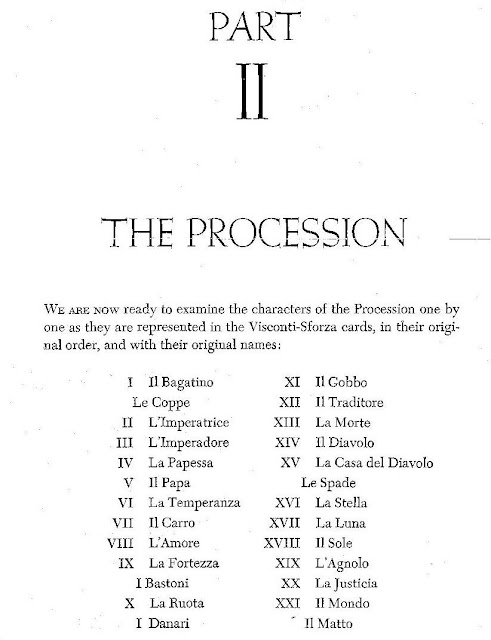
[start of p. 62]
The original names and order of the trumps are known to us from two fifteenth-century sermons and from a set of versified tarocchi of the same period, written in honor of the ladies of Ferrara. One of the sermons is cited and quoted by Steele ("Notice"). The preacher speaks of three kinds of gambling games: dice, cards ("denarii, cuppe, bastoni, enses"), and triumphs; so in his time they must still have been a separate game. His list of the trumps is essentially the same as that in the versified tarocchi, except that he calls Il Traditore "Lo impichato" and the Casa del Diavolo "La sagitta," and his name for Bagatino is "El bagatella." His list is in a queer mixture of Latin, Italian, and Spanish. The other sermon is cited and quoted in Hargrave (History) p 227 and 387. It has the same list as in the other sermon except that the spelling is slightly different. The versified tarocchi ("Trionphi de tarocchi appropriate") are from Bertoni (Poesie) p 220. As the names in this list are more like modem Italian, I have preferred to use them. Anther source for the order of the trumps, but not for their names, is a set of two uncut sheets of fifteenth- or sixteenth-century tarocchi in the Metropolitan Museum of Art in New York (26.101.5 and 31.54.159 in the print collection). It is not complete, the cards have numbers but no names, and in it the top of the Popess' head appears with the numeral III, so in this set she has already begun her descent. Otherwise there are no differences from the other three sources.
 I IL BAGATINO (Quarterpenny, The Juggler) [M. Howard comment: here I use the color reproduction in Dummett, The Visconti-Sforza Tarot Cards, 1986.]
I IL BAGATINO (Quarterpenny, The Juggler) [M. Howard comment: here I use the color reproduction in Dummett, The Visconti-Sforza Tarot Cards, 1986.]The lowest of the trumps, as we have said, is the Carnival King, Bagatino (Quarterpenny). The procession of triumphs which he leads is taking him to his own execution. The card shows Bagatino on the last day of the Carnival, when he is having his last meal. He is still dressed in holiday red and green, and has in his left hand the simple rod which is the sign of royal office. His right hand hovers uncertainly over a covered dish, which is white with touches of gray. We see by this how he became the Little Juggler of the later commedia dell'arte. That dish-cover offers many opportunities for cleverly "nervous" comic juggling. In the modern tarocchi Bagatino is often a juggler or conjurer, and his kingly rod becomes a magician's wand.
Before the Carnival King is executed, he is first given a trial, and accused of keeping people up late and making them drunk. Often a personification of Lent accompanies the procession to be sure that King Carnival gets his just deserts.
[start p. 63]
NOTES IL BAGATINO
For the theory that Bagatino is the Carnival King I have no direct authority. It is based on these facts: (1) Bagatino must be a proper name, since the modern form of it, Bagatto, has no meaning except "the first of the tarocchi trumps." (2) The clowns of the commedia dell'arte were thought of as Carnival figures, and one of them was named Bagatino: cf Harlequin, by Thelma Niklaus (New York, Braziller 1956) p 42; The Italian Comedy, by P. L. Duchartre (New York, John Day Co 1929) p 16o and pl1 showing Bagatino as the Little Juggler, facing p 228; also Pulcinella, by A. G. Bragaglia (Roma, G. Casing 1953) p 49-50. The whole triumphal procession may have become a comedy troupe, but for this I have no authority, though Brueghel's painting, "The Battle of Carnival & Lent," strongly suggests it. (3) Playing cards were associated with Carnival, and often forbidden by law at other times; cf Arch stor ital, 4 ser, xviii (1886) 28-29, for one instance. (4) As Il Matto is Lent accompanying the procession (see notes on that card), it seems likely that this is Carnival's farewell procession. I was convinced of this long before I had any idea as to the character of Bagatino. When I found that his rod was a sign of royal office it struck me that he was, of course, the King of the Carnival. For the plain rod as sign of royalty see the Empress in our set, the King in the so-called "Tarot of Mantegna," and a picture of "L'Imperatore Sigismondo in Trono" (detail of pavement in the cathedral at Siena, by Domenico di Bartolo d'Asciano (Assum (1), pl facing p 80.)
For the custom of personifying the Carnival and trying him for his sins see Sir James G. Frazer The Golden Bough, pt III "The Dying God" (London 1951) passim.
In the Milanese dialect (see Angiolini, Vocabolario) the word bagatt has come to mean "chatterbox," "the first of the tarocchi," "cobbler"; and "scarta bagatt" means "to make a long speech" and also "to speak one's whole mind." This throws a good deal of light on Bagatino's character; he was evidently a juggler with a good line of patter. As to "cobbler," in modern Italian tarocchi there is often a shoe on the table in this card. When I saw the Visconti-Sforza tarocchi in the Morgan Library, this card was in an envelope marked "Cobbler," although in the library's catalog it was titled "Castle of Plutus."
No comments:
Post a Comment